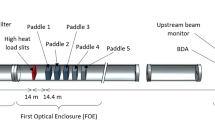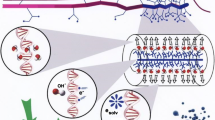Abstract
Following a significant increase in the number of facilities in the world having and developing low- and high-linear energy transfer (LET) microbeams for experimental radiobiological studies, it is useful and demanding to establish reliable computational models to analyze such experiments. This paper summarizes initial MCNP5 calculations of the basic parameters needed to study X-ray microbeam penetration, dose deposition and dose spatial dissipation in tissue-like media of micro and macro scales. The presented models can be used to predict doses delivered to neighboring cells and analyze the cause of bystander cell deaths. In the case of low-LET radiation, dose distribution is more homogenized when compared to high-LET that deposits almost all of its energy in the cell hit by radiation. Results are presented for a microbeam of monoenergetic soft (2–10 keV) X-rays for two different micro-models: (a) single-cells of homogeneous and uniform chemical compositions, and (b) single-cells of heterogeneous structures (nucleus and cytoplasm) with different chemical compositions. In both numerical models, only one cell is irradiated and the electron and X-ray doses in all cells are recorded. It was found that surrounding cells receive approximately five orders of magnitude less dose than the target cell in the homogenized cell model. The more detailed, heterogeneous model showed that the nucleus of the target cell receives more than 95% of the dose delivered to the entire cell, while neighboring cell nuclei receive approximately 65% of their total cell dose. Results of the macroscopic behavior of a soft X-ray microbeam using a cylindrical phantom 5 cm tall and 1 cm in diameter are also presented. Three-dimensional dose profiles indicate the spatial dose dissipation. For example, a 10 keV X-ray microbeam dose scatters to a negligible level at 0.3 cm radially from the center while it reaches an axial depth of 2 cm.











Similar content being viewed by others
References
Prise KM, Belyakov OV, Folkard M, Michael BD (1998) Studies of bystander effects in human fibroblasts using a charged particle microbeam. Int J Radiat Biol 74:793–798
Randers-Pehrson G, Geard CR, Johnson G, Elliston CD, Brenner DJ (2000) The Columbia University single-ion microbeam. Radiat Res 156:210–214
Resat MS, Morgan WF (2004) Microbeam developments and applications: a low linear energy transfer perspective. Cancer Metastatis Rev 23:323–331
Folkard M, Schettino G, Vojnovic B, Gilchrist S, Michette AG, Pfauntsch SJ, Prise KM, Michael BD (2001) A focused ultrasoft X-ray microbeam for targeting cells individually with submicrometer accuracy. Radiat Res 156:796–804
Schettino G, Folkard M, Prise KM, Vojnovic B, Held KD, Michael BD (2003) Low-dose studies of bystander cell killing with targeted soft X-rays. Radiat Res 160:505–511
Schettino G, Folkard M, Michael BD, Prise KM (2005) Low-dose binary behavior of bystander cell killing after microbeam irradiation of a single cell with focused Ck X-rays. Radiat Res 163:332–336
“Stopping Power and Range Tables for Electrons, Protons and Helium Ions”. NIST Physics Laboratory Physical Reference Data. http://physics.nist.gov/PhysRefData/Star/Text/contents.html (September 25, 2005)
Hall EJ (2003) The bystander effect. Health Phys 85:31–35
Jevremovic T (2005) Nuclear principles in engineering. Springer, Berlin Heidelberg New York
“XCOM Photon Cross Section Library Database” NIST Physics Laboratory Physical Reference Data. http://physics.nist.gov/PhysRefData/Xcom/Text/XCOM.html (September 25, 2005)
X-5 Monte Carlo Team (2003) MCNP—a general Monte Carlo N-particle transport code, version 5, vols 1–3. Los Alamos National Laboratory, LA-UR-03-1987, LA-CP-03-0245, and LA-CP-03-028
Alard JP, Bodez V, Tchirkov A, Nenot ML, Arnold J, Crespin S, Rapp M, Verrelle P, Dionet C (2002) Simulation of neutron interactions at the single-cell level. Radiat Res 158:650–656
Miller JH, Sowat Resat M, Metting NF, Wei K, Lynch DJ, Wilson WE (2000) Monte Carlo simulation of single-cell irradiation by an electron microbeam. Radiat Environ Biophys 39:173–177
“Tables of X-Ray Mass Attenuation Coefficients and Mass Energy-Absorption Coefficients” NIST Physics Laboratory Physical Reference Data. http://physics.nist.gov/PhysRefData/XrayMassCoef/cover.html (September 25, 2005)
Van Dyk J (1999) The modern technology of radiation oncology. Medical Physics Publishing, Madison
Prise KM, Folkard M, Michael BD (2003) A review of the bystander effect and its implications for low-dose exposure. Radiat Prot Dosimetry 104:347–355
Basic Beamline Information. Advanced Photon Source Home. http://www.aps.anl.gov/About/ResearchTeams/beamlineinformation.html (February 12, 2005)
Acknowledgments
This research was partially supported through Purdue Research Foundation Grant and partially through Grant Number 2402-PU-DOE-4423 under the Innovations in Nuclear Infrastructure and Education (INIE) Program of the US Department of Energy.
Author information
Authors and Affiliations
Corresponding author
Rights and permissions
About this article
Cite this article
Clarke, S.D., Jevremovic, T. MCNP5 evaluation of dose dissipation in tissue-like media exposed to low-energy monoenergetic X-ray microbeam. Radiat Environ Biophys 44, 225–233 (2005). https://doi.org/10.1007/s00411-005-0019-y
Received:
Accepted:
Published:
Issue Date:
DOI: https://doi.org/10.1007/s00411-005-0019-y




